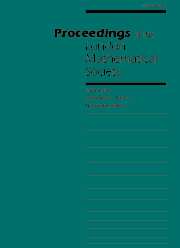Article contents
Inner derivations and primal ideals of C*-algebras, II
Published online by Cambridge University Press: 13 January 2004
Abstract
Let $A$ be a non-commutative normed algebra with centre $Z(A)$. A simple application of the triangle inequality shows that if $a \in A$ is close to $Z(A)$ then $a$ almosts commutes with elements of the unit ball of $A$. The extent to which the converse holds is a fundamental question in the study of non-commutativity and has been previously investigated for various classes of Banach algebras, including von Neumann algebras and other C*-algebras. In this context, $K(A)$ is defined to be the smallest number in $[0, \infty]$ such that $$ {\rm distance}(a, Z(A)) \leq K(A) \Vert {\rm ad}(a) \Vert $$ for all $a \in A$, where ${\rm ad}(a)$ is the inner derivation $x \to xa-ax$ for $(x \in A)$. For a C*-algebra $A$, the constant $K_s(A)$ is defined similarly, restricting to self-adjoint $a \in A$.
For a unital C*-algebra $A$, it is already known that the only possible values for $K_s(A)$ are $ \frac{1}{2}, 1, \frac{3}{2}, \ldots, \infty $, that $K(A) \in \{\frac{1}{2}, \frac{1}{\sqrt{3}}\} \cup [1, \infty]$ and that these cases are distinguished by purely topological conditions on the primitive ideal space ${\rm Prim}(A)$. In this paper, further progress is made on the question of possible values for $K(A)$ in $[1, \infty]$. It is shown that $ K(A) \leq \frac{2}{\sqrt{3}}K_s(A)$ and that either $ K(A) \leq \frac{4}{\sqrt{15}} \sim 1.033$ or $ K(A) \geq \frac{1}{2} + \frac{1}{\sqrt{3}} \sim 1.077$. The values $\frac{4}{\sqrt{15}}$ and $\frac{1}{2} + \frac{1}{\sqrt{3}}$ are attained and each of them arises as the maximal bounding radius of a constrained subset of the plane which is obtained from the structure of ${\rm Prim}(A)$.
It is also shown that if $A$ has trivial centre then $K(A)$ is further restricted: $$ K(A) \in \{\frac{1}{2}, 1, \frac{1}{2} + \frac{1}{\sqrt{3}}\} \cup [\frac{3}{2}, \infty].$$ Again, the various cases are distinguished by purely topological conditions on ${\rm Prim}(A)$, some of which are expressed in terms of primal ideals.
Keywords
- Type
- Research Article
- Information
- Copyright
- 2004 London Mathematical Society
- 4
- Cited by


